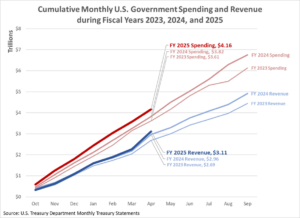Too Big to Turn?: Moody’s Credit Rating Downgrade
Imagine that you are the captain of a huge boat, like a modern container ship or even the legendary Titanic. You’re sailing forward at full throttle when an iceberg is sighted dead ahead. You need to change course because the damage will sink your ship if you hit the iceberg.
You turn the wheel as hard to starboard as you can, but almost nothing happens despite your emergency maneuver. That’s because the ship you’re trying to steer to avoid a collision is so massive and has so much inertia that it simply cannot turn as fast as you need it to. It is starting to turn, but it is turning so slowly that your action might not be enough to avoid disaster.
The U.S. government’s spending during its 2025 fiscal year is much like that.
From Full Throttle Spending to Emergency Maneuvers
The Biden-Harris administration cranked up federal government spending to the fastest it’s ever been in its final months in office as it lost its hold on power. From October 2024 through January 2025, the U.S. government spent more money faster than it ever had at the start of any fiscal year in history.
Although the incoming Trump administration acted quickly to change the government’s fiscal course, the U.S. government’s fiscal trajectory has remained largely unchanged.
But it is changing. The April 2025 Monthly Treasury Statement provides solid evidence the nation’s fiscal trajectory has begun to change direction. The chart below shows how the U.S. government’s spending for FY 2025 compares with its previous two fiscal years through April 2025.

The most visible change has taken place in the U.S. government’s revenues. Through the end of April 2025, the U.S. government has collected $3.11 trillion during FY 2025, about $150 billion more than it did through the same point of time in FY 2024. Politico reports a large portion of that increase came from President Trump’s newly enacted tariffs.
Slowing U.S. Government Spending
Less visible is a change in the rate of U.S. government spending since January 2025. Under the outgoing Biden-Harris administration, the U.S. government spent an average of almost $610 billion per month from October 2024 through January 2025.
Under the Trump administration, that spending has slowed to an average of about $570 billion per month from January through April 2025. As a result, the U.S. government’s total spending through April 2025 is $100 billion lower than if it had kept going at the rate set by the Biden-Harris administration.
Not Enough to Avoid Danger of Hitting Fiscal Iceberg
In November 2023, Moody’s Investor Service downgraded its outlook for the U.S. government’s credit rating to negative. That announcement put the federal government’s last AAA credit rating in jeopardy.
It also put the Biden-Harris administration on notice. Unless they acted to correct the government’s fiscal course, Moody’s would cut the U.S. government’s credit rating.
That never happened. Instead, the Biden-Harris administration pushed the spending throttle forward to full speed in their final months, with officials even bragging they were tossing gold bars off the Titanic ship of state.
Even with the Trump administration’s attempted course correction, it wasn’t enough to avoid the consequences of that foolish fiscal policy. Moody’s cut the U.S. government’s credit rating on Friday, May 16, 2025. In doing so, Moody’s became the third of the three major credit rating agencies to reduce the U.S. government’s credit rating below their top AAA rating.
Whether the U.S. Government strikes the fiscal iceberg now dead ahead depends on the actions of the members of the U.S. Congress. That’s scary because about half of the members of this body don’t think their excessive spending rate is a problem. That is, of course, the real problem.
This piece was originally posted by The Independent Institute.
